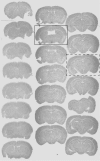Standards of evidence in chronobiology: A response
- PMID: 19624818
- PMCID: PMC2724488
- DOI: 10.1186/1740-3391-7-9
Standards of evidence in chronobiology: A response
Abstract
A number of recent studies have debated the existence and nature of clocks outside the suprachiasmatic nucleus that may underlie circadian rhythms in conditions of food entrainment or methamphetamine administration. These papers claim that either the canonical clock genes, or the circuitry in the dorsomedial nucleus of the hypothalamus, may not be necessary for these forms of entrainment. In this paper, we review the evidence necessary to make these claims. In particular, we point out that it is necessary to remove classical conditioning stimuli and interval timer (homeostatic) effects to insure that the remaining entrainment is due to a circadian oscillator. None of these studies appears to meet these criteria for demonstrating circadian entrainment under these conditions. Our own studies, which were discussed in detail by a recent Review in these pages by Mistlberger and colleagues, came to an opposite conclusion. However, our studies were designed to meet these criteria, and we believe that these methodological differences explain why we find that canonical clock gene Bmal1 and the integrity of the dorsomedial nucleus are both required to produce true circadian entrainment under conditions of restricted feeding.
Figures





Similar articles
-
Standards of evidence in chronobiology: critical review of a report that restoration of Bmal1 expression in the dorsomedial hypothalamus is sufficient to restore circadian food anticipatory rhythms in Bmal1-/- mice.J Circadian Rhythms. 2009 Mar 26;7:3. doi: 10.1186/1740-3391-7-3. J Circadian Rhythms. 2009. PMID: 19323828 Free PMC article.
-
Hepatic, duodenal, and colonic circadian clocks differ in their persistence under conditions of constant light and in their entrainment by restricted feeding.Chronobiol Int. 2011 Apr;28(3):204-15. doi: 10.3109/07420528.2010.548615. Chronobiol Int. 2011. PMID: 21452916
-
Entrainment of the mouse circadian clock: Effects of stress, exercise, and nutrition.Free Radic Biol Med. 2018 May 1;119:129-138. doi: 10.1016/j.freeradbiomed.2017.12.026. Epub 2017 Dec 23. Free Radic Biol Med. 2018. PMID: 29277444 Review.
-
Functional CLOCK is not involved in the entrainment of peripheral clocks to the restricted feeding: entrainable expression of mPer2 and BMAL1 mRNAs in the heart of Clock mutant mice on Jcl:ICR background.Biochem Biophys Res Commun. 2002 Oct 25;298(2):198-202. doi: 10.1016/s0006-291x(02)02427-0. Biochem Biophys Res Commun. 2002. PMID: 12387815
-
Neurobiology of food anticipatory circadian rhythms.Physiol Behav. 2011 Sep 26;104(4):535-45. doi: 10.1016/j.physbeh.2011.04.015. Epub 2011 Apr 20. Physiol Behav. 2011. PMID: 21527266 Review.
Cited by
-
Timing Mechanisms for Circadian Seizures.Clocks Sleep. 2024 Oct 21;6(4):589-601. doi: 10.3390/clockssleep6040040. Clocks Sleep. 2024. PMID: 39449314 Free PMC article. Review.
-
Bmal1 in the nervous system is essential for normal adaptation of circadian locomotor activity and food intake to periodic feeding.J Neurosci. 2011 Oct 26;31(43):15391-6. doi: 10.1523/JNEUROSCI.2801-11.2011. J Neurosci. 2011. PMID: 22031885 Free PMC article.
-
Differential effects of light and feeding on circadian organization of peripheral clocks in a forebrain Bmal1 mutant.Elife. 2014 Dec 19;3:e04617. doi: 10.7554/eLife.04617. Elife. 2014. PMID: 25525750 Free PMC article.
-
Impaired function of the suprachiasmatic nucleus rescues the loss of body temperature homeostasis caused by time-restricted feeding.Sci Bull (Beijing). 2020 Aug 15;65(15):1268-1280. doi: 10.1016/j.scib.2020.03.025. Epub 2020 Mar 19. Sci Bull (Beijing). 2020. PMID: 32864176 Free PMC article.
-
The Mysterious Food-Entrainable Oscillator: Insights from Mutant and Engineered Mouse Models.J Biol Rhythms. 2018 Oct;33(5):458-474. doi: 10.1177/0748730418789043. Epub 2018 Jul 23. J Biol Rhythms. 2018. PMID: 30033846 Free PMC article. Review.
References
-
- Mistlberger RE, Buijs RM, Challet E, Escobar C, Landry GJ, Kalsbeek A, et al. Standards of evidence in chronobiology: critical review of a report that restoration of Bmal1 expression in the dorsomedial hypothalamus is sufficient to restore circadian food anticipatory rhythms in Bmal1-/- mice. J Circadian Rhythms. 2009;7:3. - PMC - PubMed
-
- Stephan FK. The "other" circadian system: food as a Zeitgeber. J Biol Rhythms. 2002;17:284–292. - PubMed
-
- Landry GJ, Yamakawa GR, Webb IC, Mear RJ, Mistlberger RE. The dorsomedial hypothalamic nucleus is not necessary for the expression of circadian food-anticipatory activity in rats. J Biol Rhythms. 2007;22:467–478. - PubMed
-
- Landry GJ, Simon MM, Webb IC, Mistlberger RE. Persistence of a behavioral food-anticipatory circadian rhythm following dorsomedial hypothalamic ablation in rats. Am J Physiol Regul Integr Comp Physiol. 2006;290:R1527–R1534. - PubMed
LinkOut - more resources
Full Text Sources

